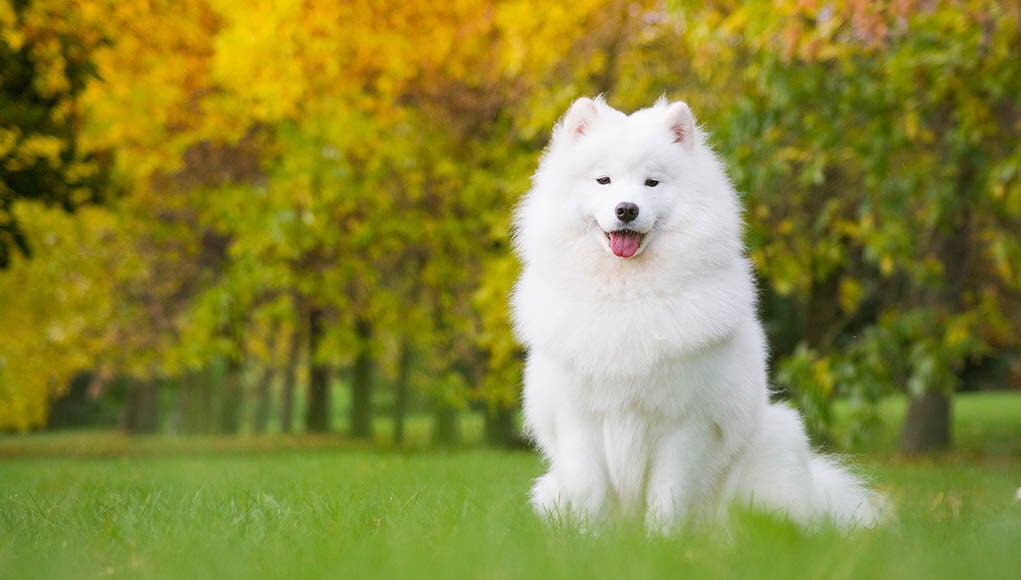Table of Contents
Pretty and intelligent—these are just a few things we can describe the Samoyed. These dogs might look like lap dogs, but they are capable of much more than that.
This blog will discuss everything you need to know about the Samoyed dog breed.
The Samoyed dog breed was initially bred to hunt, haul sleds, and herd reindeer to help northwestern Siberia's Samoyede people. But their skills don't stop there.
They are also capable of pack hiking, tracking, and warming their owners by snuggling on top of them at night.
Samoyeds are medium-sized, squarely built, and sturdy dogs that are part of the Nordic Spitz breed.
A Spitz breed is a group of northern dogs. Other examples of the Spitz dog breeds are the Chow chow, Pomeranian, and Alaskan Malamute.
If you're planning to adopt a Samoyed puppy, you better scroll down!
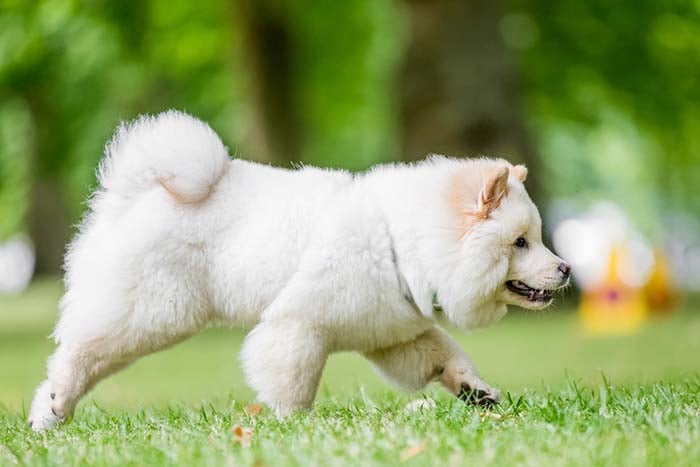
Samoyed History
At first glance, the samoyed looks like the typical cuddly dog that loves to be around you all the time.
But this sweet-tempered dog breed was originally used to hunt prey, herd reindeer, and haul sleds for the Siberian Samoyede people.
According to its history, the Samoyede people treated these dogs like they were part of the family.
These dogs provided warmth and companionship to them. They let them join in different kinds of family activities after working alongside them all day.
The Samoyed traveled out of Siberia at the end of the 19th century and the earlier part of the 20th century to pull sleds on polar expeditions. This includes Sir Ernest Shackleton's expedition to the Antarctic.
In the late 1800s, Samoyeds first came to England as gifts from the Czar of Russia. It is also said that Queen Alexandra's favorite dog is the Samoyed.
In this day in age, there are still plenty of Samoyeds that still work today. These dogs still help with herding reindeer and pulling sleds.
However, they are now also popular for being great family companions all over the world.
Physical Characteristics of Samoyed Dog Breed
The Samoyed dogs have excellent physical traits. For instance, their best physical trait is their sparkling white coat. That should be expected for a dog breed from the northern area.
Their coat is thick, harsh, and straight with a very full undercoat. The majority of them have white coats, but they also come in biscuits or cream.
Samoyeds vary in size and weight depending on gender.
A male Samoyed stands 21–23.5 inches tall, weighing at least 50 to 60 pounds. On the other hand, female Samoyeds stand at 19 inches to 21 inches and weigh the same average as males.
Keep in mind that their weight should be proportional to their overall size.
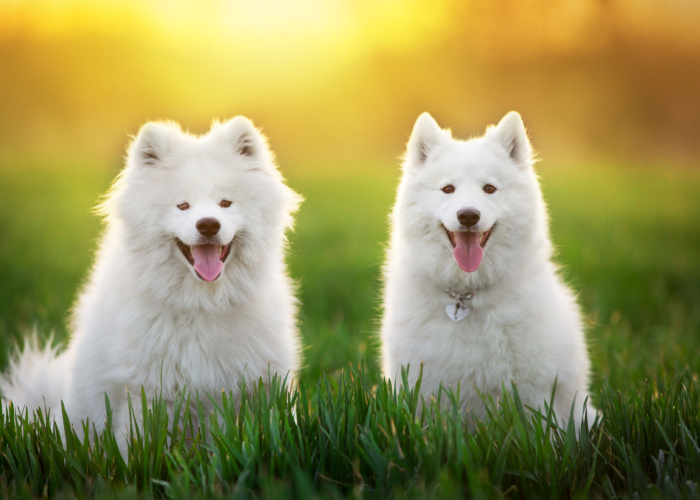
The Temperament of the Samoyed
Samoyeds are friendly, intelligent, and gentle dogs. They are loyal and affectionate to his family.
Bred to live in a tent in close quarters with their families, these dogs thrive in human companionship.
Remember that temperament doesn't happen quickly. It can be altered by numerous aspects such as heredity, training, and socialization.
If you're looking to adopt a Samoyed puppy, puppies with good temperaments are playful. They are also curious, and they approach people wanting to be petted or held by them.
Meeting at least one of the puppy's parents or other siblings can also help evaluate or determine that dog's personality when he grows up.
But generally, Samoyeds are playful and adventurous. They are great companions for people of all ages. That's why they are also good family dogs.
Samoyeds' loyalty and alertness qualify them to be good watchdogs as well.
Even though Samoyeds are a little bit independent, they are not considered “lone wolf” dogs.
They love to be close to their family members. It is also not recommended for these dogs to be left alone at home or in a kennel.
Living with a Samoyed
Samoyeds are affectionate and deeply attached to its family. If your pup has undergone proper socialization, they'll for sure love the attention and companionship of children and other family members.
However, it's still best advised to monitor and guide your children and dog when they are playing. Samoyeds' size and strength can easily knock over a small child by accident.
Always supervise all interactions to avoid unwanted biting or pulling from both the child and the dog.
A good pet owner will not only train his pup but will also teach their children how to approach and touch a dog properly.
There should be no dog, no matter what the circumstance is or how friendly, should ever be left unsupervised with a child.
Samoyed dogs also enjoy playing or just chilling with other dogs, especially if they grew up together.
Instinctively, they might run around and chase after small animals that they perceive as prey. This is because they were bred to be hunters back in the day.
If you're looking to adopt a Samoyed dog, remember that they are very talkative. They voice their likes and dislikes through bellows, howls, or barks.
Working dogs like the Samoyed are best to keep busy. Bored Samoyeds tend to be annoying or exhibit destructive behaviors such as excessive barking, digging, chewing shoes, and more.
Samoyeds are active dogs and are not suitable for apartment living. It is best recommended for them to live in a house with a large and secured fence.
Since they are working dogs, they need lots of space to run around and play.
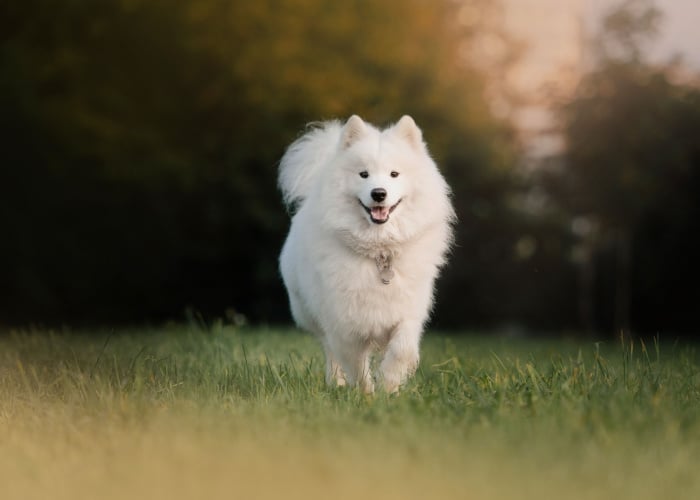
Training & Exercise
Samoyeds are intelligent dogs, and they are eager to learn. That's why a lot of them respond well during training sessions.
But that is not always the case. Some Samoyeds tend to be lazy and stubborn. Patience and consistency is the key when it comes to training these kinds of dogs.
Consistency might be the key, but you have to make sure that you don't bore your Samoyed with repetition.
Also, it's recommended to use reward-based training with their favorite dog treats that are linked by a positive tone.
You can start with agility and tracking to help maintain their mental health.
When it comes to exercise, it is best recommended for a Samoyed to have a minimum of two hours of exercise per day. The lack of exercise can lead to obesity and other health problems.
You can create a schedule for their exercise so that you're sure they are not missing any. Plan an exercise for early in the morning and later in the evening.
Avoid exercising when the temperature is high. Find the sweet spot where the temperature is tolerable.
These dogs enjoy long walks and lots of playtimes in the park or the yard. Just make sure that your back garden is secured since Samoyeds are known to be escape artists.
Health Care of Samoyeds
Generally, the Samoyed is a healthy dog breed. But just like any other breed, they are prone to certain health issues.
This doesn't mean that your Samoyed will get any of these health problems. However, as pet owners, we need to be aware of them.
If you're trying to adopt a Samoyed puppy, find a reputable breeder. A responsible dog breeder can show you health clearances for the puppy and its parents.
You can ask the breeder for clearances from the Orthopedic Foundation for Animals for hip dysplasia, elbow dysplasia, hypothyroidism, and Von Willebrand's Disease.
Now, let's discuss a few health concerns that Samoyeds are susceptible to.
Hip Dysplasia
First on the list is hip dysplasia. It is a genetic condition wherein the socket of the joint and ball becomes distorted.
Medium to large-sized dogs are more prone to this condition due to their large stature. Their mass stresses their lower body areas, especially in their joints.
When a dog is diagnosed with hip dysplasia, it’s essential to keep its weight in the normal range and have them exercise with activities that promote joint therapy.
Veterinarians may prescribe medications for anti-inflammatory/ pain relievers and supplements.
Glaucoma
Glaucoma can be either hereditary or caused by other eye diseases.
It is a condition that disrupts the balance of production and drainage of fluid in the eyes and increases eye pressure. Some of the symptoms may include pain and vision loss.
Usually, glaucoma is removed via surgery, and eye drops will be prescribed.
Hypothyroidism
One of the most common hormonal problems in dogs is hypothyroidism. It is a disorder of the thyroid gland.
Sometimes, it is responsible for epilepsy, alopecia, obesity, lethargy, hyperpigmentation, and other skin issues.
For treatment, pet owners resort to medication and certain changes in diet. For instance, here's a quick recipe for homemade dog food for hypothyroidism.
Progressive Retinal Atrophy
Progressive Retinal Atrophy (PRA) is also a problem for Samoyeds. PRA is a degenerative disease that affects the rod and cone cells in the eyes that leading to blindness.
It is also a hereditary disease that is known to have no treatment yet. Unfortunately, this disease can progress quickly from a year or two.
Have your Samoyed regularly checked to reduce the risk of this condition.
Samoyed Hereditary Glomerulopathy
Another health condition that Samoyeds are prone to have is Samoyed Hereditary Glomerulopathy or SHG.
It is a hereditary disease of the kidney in Samoyed dogs. And there's still no genetic screening test available for this condition.
Unfortunately, SHG is more severe in male Samoyeds, who appear to be healthy for the first three months until signs appear.
Death can be caused by renal failure by 15 months of age. Female Samoyeds usually develop mild symptoms at 2 to 3 months of age.
Patellar Luxation
Patellar Luxation occurs when the patella shifts its alignment out of the femur. Similar to the conditions above, Patellar Luxation is a hereditary disorder in dogs.
This can range from high to low levels of luxation, and each requires different cures.
Signs may include skipping and kicking off the leg. It’s best to consult with the vet for treatments, therapies, or procedures required to help a Samoyed with this condition.
Remember not to breed Samoyed dogs who have these diseases. It’s best not to bring these despairing conditions to their descendants.
Diabetes Mellitus
Diabetes Mellitus or DM is a disorder where the body can't regulate blood sugar levels. Sometimes, diabetes in dogs is hard to spot.
A diabetic dog will show a healthy appetite but will lose weight because the food they are taking is not being used efficiently.
Other symptoms of diabetes are:
- Excessive water drinking
- Increased urination
- Weight loss
- Loss of appetite
- Cloudy eyes
- Chronic infections
Subvalvular Aortic Stenosis
Subvlavular Aortic Stenosis is a heart issue caused by a narrow connection between the left ventricle and the aorta.
Dogs that suffer from this disease can exhibit fainting and can even be fatal at times.
Cancer
Monitor your pet for abnormal swelling or bump sores that don't heal. You should also check if there is bleeding from any body opening and if they have difficulties in breathing or elimination.
Treatment will depend on the kind of cancer, but it usually includes surgery, chemotherapy, radiotherapy, and medications.
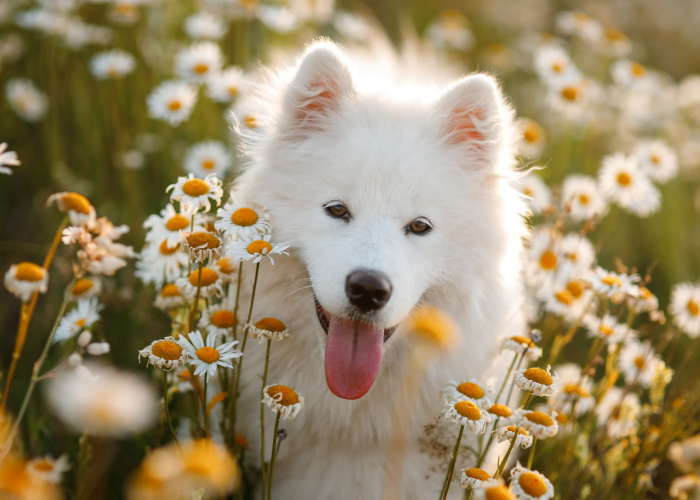
Grooming
If you're planning to adopt a Samoyed dog, you have to know that the overall grooming needs are high.
The main attraction when it comes to the Samoyed is its white coat. Samoyeds have a straight outer coat and a thick undercoat.
Once or twice a week brushing is needed for these heavy shedders. When it's shedding season, daily brushing is necessary.
Bathing is needed about once every eight weeks or whenever they play around dirt or roll into something smelly.
Proper bathing and drying help with maintaining their beautiful and healthy coat. When the coat is dirty, the hair shaft tends to become rough and will break down. That can lead to damage to their coats.
The lack of proper grooming can also resort in the formation of cobweb matting that forms near the skin. This matting can lead to multiple skin issues when left untreated.
Nail trimming is also important to dogs. A good rule of thumb is not to let their nails touch the ground.
If you hear these clicky sounds while they walk, it means it's time to clip their nails.
Frequently Asked Questions about the Samoyed Dog Breed
Is Samoyed an indoor dog?
No, Samoyeds are not recommended for long-term apartments or indoor living. These working dogs were bred to roam, hunt, herd, and haul sleds.
Samoyeds need a spacious outdoor for them to run around and get the right amount of exercise per day.
If you're planning to adopt a Samoyed, it's best to have a large and secured fenced yard.
Is a Samoyed a husky?
Samoyeds and Siberian Huskies are two different breeds.
But they do have similarities. For example, both the Huskies and Samoyeds are considered Spitz breeds.
Another similarity between the two dogs is that they both originate from the northwestern region of Russia.
Are Samoyed dogs lazy?
Samoyeds may look calm on the outside, but they are not considered lazy dogs. These dogs are active and need lots of exercise to enhance their quality of life.
They also get bored easily that's why you need to distract them with different activities for their physical and mental health.
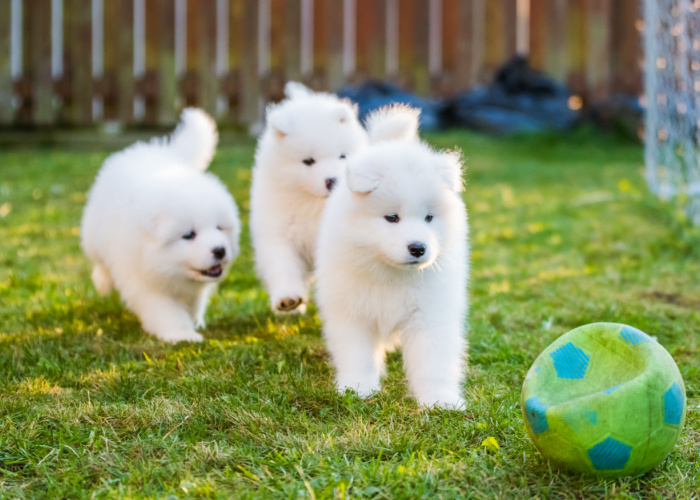
Samoyed Dog Breed Profile: Summary
Samoyeds are not your typical pretty boy dog. They might look majestic and soft, but they are capable of much more.
Samoyeds were originally bred to hunt, herd reindeer, and haul sleds with the Samoyede people in Siberia. But even if they were working dogs, they were also great companions for the tribe.
These dogs are also highly intelligent. That's why it's important to keep them entertained, as they get bored easily.
Samoyeds are affectionate, and they love their family. If your Samoyed has undergone proper socialization, he can be a great addition to the family even with children.
And since they are working dogs, their exercise requirement is a minimum of two hours every day.
They like to go on long walks, and they love playtime. Not only will this help their physical health, but it also keeps their brain active.
Samoyeds are generally healthy dogs. But just like any other pup, they are susceptible to certain types of diseases.
If you're planning to adopt a Samoyed puppy, make sure that you're adopting from a reputable breeder. Ask them for health clearances for both the puppy and its parents.


